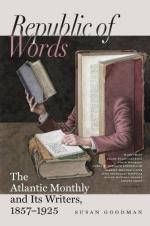“aloft would hang White summer-lightnings; as it sank and sprang To measure, that whole palpitating breast Of heaven, ’t was Apollo, Nature prest At eve to worship.”
Then comes a portrait of Palma, done with Titian’s brush and manner. As we turn the leaves where favorite passages lie brilliantly athwart the faded politics of an old story, we are tempted to try spinning its thread again for the sake of holding up these lines, which are among the most delicate and sumptuous that Mr. Browning ever wrote. But room is at present dear as paper. Only turn, for instance, to pages 39-45, 72-74, the picturesque scenes on pages 84, 85, the opening of Book IV., Salinguerra’s portrait, like an old picture of Florence, on page 127, and lines single and by the half-dozen everywhere.
The tragedy of “Strafford” is one of Mr. Browning’s earliest compositions. It was once placed upon the stage by Mr. Macready, but it is no more of an acting play than all the other pieces of Mr. Browning, and is too political to be good reading. The characters seem to be merely reporting the condition of parties under Charles I.; this and the struggle of the King with the Parliament are told, but are not represented, the passions of the piece belong too exclusively to the caucus and the council-chamber, and even the way in which the King sacrifices Strafford does not dramatically appear. In the last act, there is much tenderness in the contrast of Stratford’s doom with the unconsciousness of his children, and pathos in his confidence to the last moment that the King will protect him. The dialogue is generally too abrupt and exclamatory. Vane speaks well on page 222, and Hampden on page 231, and there are two good scenes between Charles and Strafford, where the King’s irresolution appears against the Earl’s devotedness. The closing scene of Act IV. has the dramatic form, but it is interfused with mere civil commotion instead of color, and the motive is a transient one, important only to the historian. But we need not multiply words over that one of all his compositions which Mr. Browning probably now respects the least.
“Christmas-Eve and Easter-Day” is a beautiful poem, filled with thought, humor, and imagination. The mythical theory of Strauss was never so well analyzed as in the tilting lines from page 353 to 361. And there is good theology in this:—
“Take all in a word:
the truth in God’s breast
Lies trace for trace upon
ours impressed;
Though He is so bright and
we so dim,
We are made in His image to
witness Him;
And were no eye in us to tell,
Instructed by no inner sense,
The light of heaven from the
dark of hell,
That light would want its
evidence,” etc.




